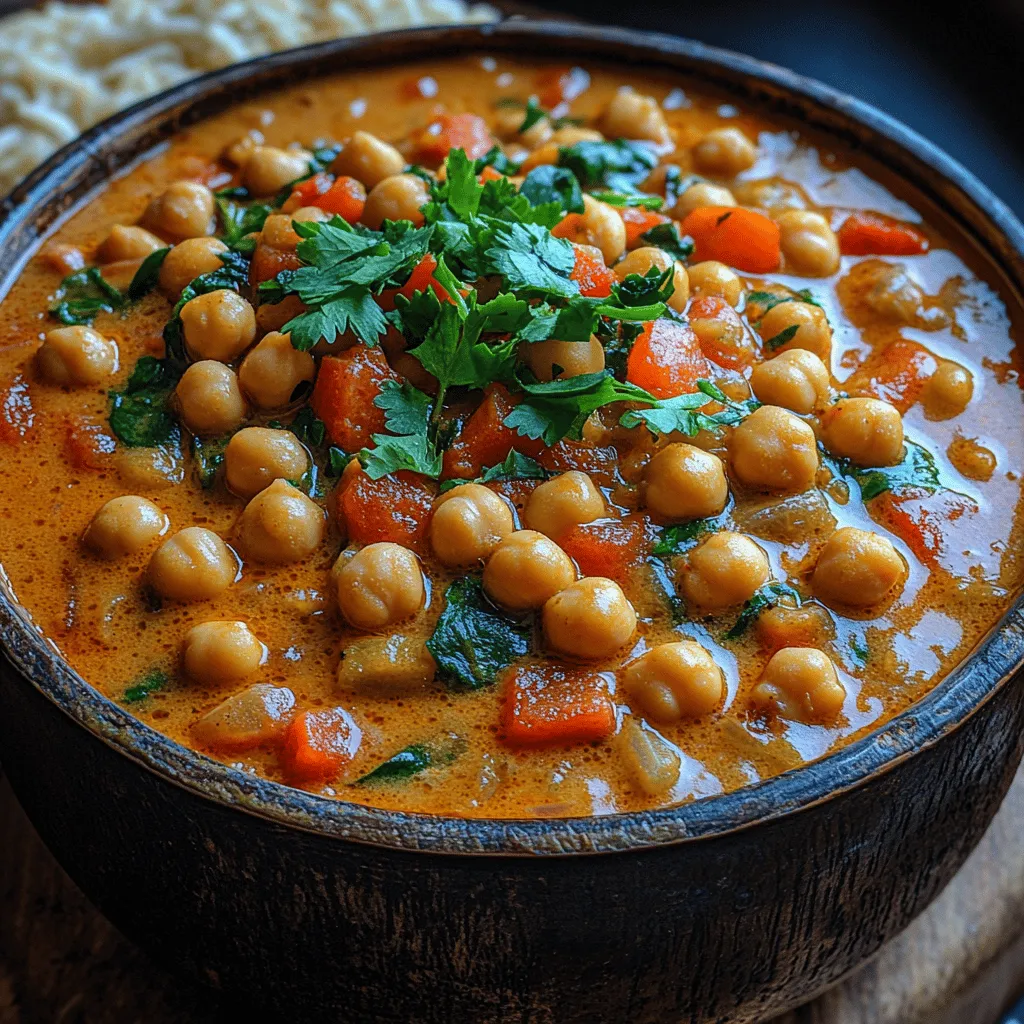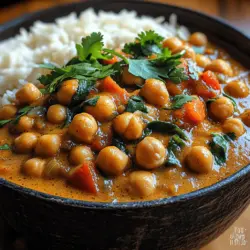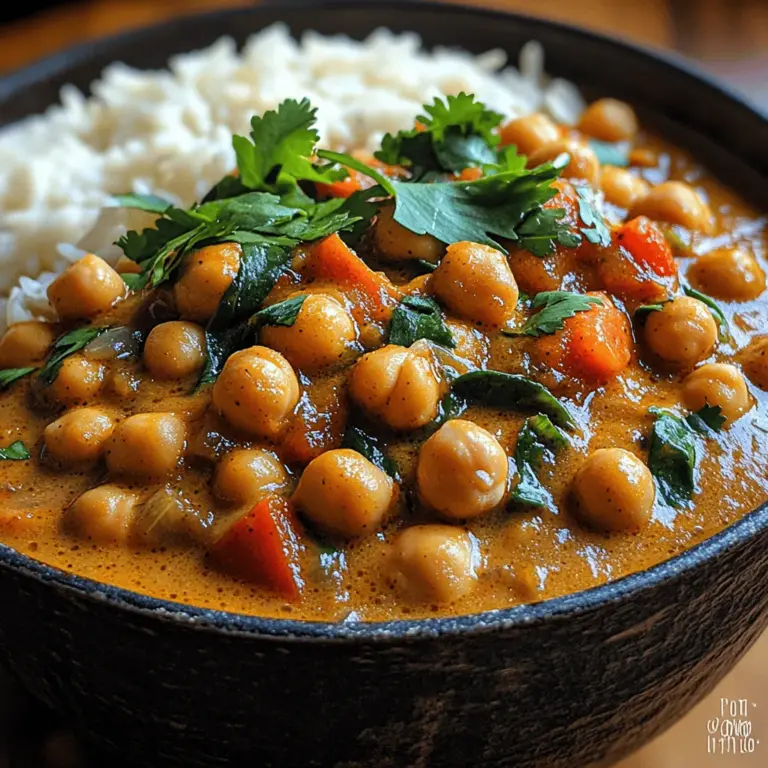Introduction
Imagine diving into a bowl of warm, comforting stew that transports you to sun-kissed beaches and lush tropical landscapes. That’s exactly what the Tropical Bliss Coconut Curry Chickpea Stew offers—a delightful fusion of flavors and textures that not only satisfies your hunger but also nourishes your body. This dish is a vibrant blend of plant-based ingredients, expertly combined to create a meal that is as nutritious as it is delicious.
In today’s world, where health and wellness are at the forefront of our culinary choices, this Coconut Curry Chickpea Stew stands out. It’s packed with wholesome ingredients that provide a wealth of health benefits. Chickpeas, for instance, are a fantastic source of plant-based protein and fiber, while coconut milk brings a rich creaminess that makes this stew feel indulgent without compromising your health goals. Whether you’re a full-time vegan, a vegetarian, or simply someone looking to introduce more plant-based meals into your diet, this stew is the perfect dish to satisfy your cravings.
Comfort food often evokes memories of hearty meals enjoyed with family and friends, and while this stew is rooted in those classic traditions, it adds an exciting tropical twist. The vibrant colors and aromatic spices create a sensory experience that elevates your dining experience. Not only is it delicious, but this stew also embodies the essence of comfort food—warm, filling, and heartening, making it an ideal dish for any time of the year.
Understanding the Key Ingredients
To fully appreciate the Tropical Bliss Coconut Curry Chickpea Stew, it’s essential to understand the key ingredients that give it its unique flavor profile and health benefits.
Coconut Oil: A Healthy Fat with a Unique Flavor
Coconut oil is a staple in this recipe and serves as the cooking fat that enhances the dish’s tropical essence. Known for its health benefits, coconut oil contains medium-chain triglycerides (MCTs), which are easily digestible fats that can provide a quick source of energy. Additionally, coconut oil has antimicrobial properties that can support overall health. Its slightly sweet and nutty flavor complements the spices and coconut milk perfectly, adding depth to the stew.
Chickpeas: Nutritional Powerhouse Packed with Protein
Chickpeas, or garbanzo beans, are the stars of this dish. These legumes are not only versatile but also incredibly nutritious. They are an excellent source of plant-based protein, making them a fantastic meat substitute for those following a vegetarian or vegan diet. Chickpeas are rich in fiber, which promotes digestive health and helps maintain steady blood sugar levels. Furthermore, they are packed with vitamins and minerals, including iron, magnesium, and folate. The addition of chickpeas in this stew adds substance and heartiness, ensuring that you feel satisfied after every bowl.
Coconut Milk: Creamy Base That Adds Richness
Coconut milk is another key ingredient that brings the stew to life. Its creamy texture creates a luscious base that binds all the flavors together. Unlike dairy milk, coconut milk is plant-based, making it suitable for those with lactose intolerance or dairy allergies. It’s also rich in healthy fats, which can help you feel fuller for longer. The subtle sweetness of coconut milk balances the savory spices and enhances the overall flavor of the dish, making each spoonful a delight.
Red Curry Paste: Essential for Flavor Depth
No curry is complete without a robust paste to serve as a flavor foundation, and red curry paste does just that in this recipe. This paste is a blend of red chili peppers, garlic, lemongrass, ginger, and other spices, creating a concentrated burst of flavor. It adds a gentle heat to the stew while infusing it with aromatic notes that evoke the essence of traditional Thai cuisine. The red curry paste is essential for achieving the stew’s authentic taste, so don’t skimp on this ingredient!
Fresh Vegetables: Importance of Colorful Veggies in the Recipe
Fresh vegetables play a crucial role in this stew, not only adding flavor but also enhancing its nutritional profile. A colorful variety of vegetables such as bell peppers, carrots, zucchini, and spinach contribute vitamins, minerals, and antioxidants essential for optimal health. Incorporating a range of colors in your meals not only makes them visually appealing but also ensures you receive a wide spectrum of nutrients. The vegetables also provide texture and crunch that contrast beautifully with the creamy base, creating a delightful eating experience.
The Benefits of Plant-Based Meals
The Tropical Bliss Coconut Curry Chickpea Stew is a shining example of the benefits of adopting a plant-based diet. With growing awareness about health and environmental issues, many people are turning to plant-based meals not only for personal wellness but also for their positive impact on the planet.
Overview of Plant-Based Diets and Their Health Benefits
Plant-based diets, which emphasize whole foods derived from plants, have been linked to a range of health benefits. Studies have shown that individuals who consume more plant-based foods tend to have lower risks of chronic diseases such as heart disease, diabetes, and certain cancers. The abundance of fruits, vegetables, whole grains, nuts, and legumes in these diets provides essential nutrients while being lower in saturated fats and cholesterol.
This stew, in particular, offers a balanced meal that’s rich in protein, fiber, and healthy fats, making it an excellent choice for anyone looking to improve their overall health. With the inclusion of chickpeas and an array of vegetables, this dish supports digestive health, helps regulate blood sugar, and contributes to sustained energy levels throughout the day.
Discussion on the Environmental Impact of Plant-Based Choices
In addition to the personal health benefits, plant-based diets are also more sustainable than meat-based diets. Livestock farming contributes significantly to greenhouse gas emissions, deforestation, and water consumption. By choosing plant-based meals like the Tropical Bliss Coconut Curry Chickpea Stew, you’re making a conscious choice to reduce your carbon footprint and support environmental sustainability. Every plant-based meal you enjoy is a step towards a healthier planet.
Highlighting the Versatility of Chickpeas and Other Ingredients
Chickpeas and other ingredients in this stew are incredibly versatile, allowing for a variety of culinary creations. Chickpeas can be roasted, blended into hummus, or used as a meat substitute in salads and wraps. They easily absorb flavors, making them suitable for a multitude of dishes across different cuisines. Similarly, the vegetables used in this stew can be swapped based on seasonal availability or personal preference, allowing you to customize the recipe to your taste. This adaptability makes plant-based cooking exciting and accessible for everyone.
Detailed Ingredient Breakdown
Now that we’ve explored the benefits of the key ingredients, let’s delve deeper into each component of the Tropical Bliss Coconut Curry Chickpea Stew. Understanding what each ingredient brings to the table can help you appreciate the dish even more.
Explanation of Each Ingredient’s Role in the Stew
1. Coconut Oil: Used for sautéing the vegetables and spices, coconut oil adds flavor and healthy fats to the stew.
2. Chickpeas: The star protein source, chickpeas provide texture and heartiness, making the stew filling and nutritious.
3. Coconut Milk: Acts as the creamy base that melds the flavors together and adds a subtle sweetness.
4. Red Curry Paste: The flavor powerhouse, red curry paste infuses the dish with heat and aromatic spices.
5. Fresh Vegetables: Each vegetable contributes unique flavors, colors, and nutrients, enhancing the overall dish.
Suggestions for Substitutions
– Chickpeas: If you don’t have chickpeas on hand, you can use other beans like black beans or lentils as a substitute.
– Coconut Milk: For a lower-fat option, consider using light coconut milk or unsweetened almond milk, although it will change the flavor and consistency slightly.
– Fresh Vegetables: Feel free to swap in your favorite vegetables such as sweet potatoes, broccoli, or green beans based on what you have available or your dietary preferences.
– Spice Levels: Adjust the amount of red curry paste to fit your heat tolerance; if you prefer milder stews, start with less and add more as needed.
Importance of Using Fresh and Organic Ingredients
Whenever possible, opt for fresh and organic ingredients. Fresh produce not only tastes better but also retains more nutrients than canned or frozen alternatives. Organic ingredients are grown without harmful pesticides, making them a healthier choice for you and the environment. Additionally, using fresh herbs like cilantro or basil as a garnish can elevate the dish’s flavor and presentation, making your Tropical Bliss Coconut Curry Chickpea Stew even more enjoyable.
Step-by-Step Preparation Guide
Now that you have a good understanding of the ingredients and their benefits, let’s move on to the step-by-step preparation of the Tropical Bliss Coconut Curry Chickpea Stew. This guide will provide clear instructions to help you create this delicious dish from start to finish.
Step 1: Gather Your Ingredients
Start by gathering all your ingredients to ensure a smooth cooking process. You will need:
– 2 tablespoons coconut oil
– 1 can (15 oz) chickpeas, drained and rinsed
– 1 can (14 oz) coconut milk
– 3 tablespoons red curry paste
– 1 bell pepper, diced
– 1 medium carrot, sliced
– 1 zucchini, chopped
– 2 cups fresh spinach
– 1 cup vegetable broth
– Salt and pepper to taste
– Fresh cilantro for garnish (optional)
Step 2: Sauté the Aromatics
In a large pot or Dutch oven, heat the coconut oil over medium heat. Once the oil is melted and shimmering, add the red curry paste. Sauté for about 1-2 minutes until the paste becomes fragrant. This step is crucial as it helps to release the flavors of the spices, enhancing the overall taste of the stew.
Step 3: Add the Vegetables
Next, add the diced bell pepper, sliced carrot, and chopped zucchini to the pot. Stir well to coat the vegetables in the curry paste. Cook for approximately 5-7 minutes, allowing the vegetables to soften and absorb the flavors.
Step 4: Incorporate the Chickpeas and Coconut Milk
Once the vegetables are tender, add the drained chickpeas and coconut milk to the pot. Stir to combine all the ingredients, and then pour in the vegetable broth. The broth will help create a stew-like consistency, so adjust the amount based on your desired thickness. Bring the mixture to a gentle simmer.
Step 5: Simmer the Stew
Reduce the heat to low and allow the stew to simmer for about 15-20 minutes. This step allows the flavors to meld together beautifully. Stir occasionally to prevent sticking, and add salt and pepper to taste. If you prefer a thicker stew, let it simmer uncovered for the last few minutes.
Step 6: Add Fresh Spinach
Just before serving, stir in the fresh spinach and cook for an additional 2-3 minutes until wilted. This step not only adds vibrant color to the dish but also boosts its nutritional value.
Step 7: Serve and Enjoy
Once the spinach is wilted and the stew is heated through, it’s ready to serve! Ladle the Tropical Bliss Coconut Curry Chickpea Stew into bowls and garnish with fresh cilantro if desired. This dish pairs beautifully with steamed rice, quinoa, or crusty bread for a complete meal.
By following these steps, you’ll create a hearty and flavorful Coconut Curry Chickpea Stew that embodies the essence of comfort food with a tropical flair. Enjoy the process and the delicious results!

Tips for Perfecting the Sautéing Process
Sautéing is a crucial step in the preparation of Tropical Bliss Coconut Curry Chickpea Stew, as it forms the flavor foundation of the dish. Here are some expert tips to ensure you achieve the best results during this process:
1. Use the Right Heat: Start with medium-high heat to get your pan hot enough to sear the onions and garlic. This will help to develop a deep flavor profile as the ingredients caramelize.
2. Don’t Overcrowd the Pan: If you’re making a large batch, sauté in batches. Overcrowding the pan can lead to steaming instead of sautéing, preventing that beautiful golden color from developing.
3. Stir Frequently: Keep your ingredients moving to avoid burning. Stirring allows for even cooking and ensures that all ingredients are coated with oil and flavor.
4. Add Ingredients in Stages: Start with the aromatics first (onions, garlic, and ginger), followed by harder vegetables (like carrots or bell peppers), and then the softer ones (like zucchini or spinach). This layering helps to build complex flavors.
5. Deglaze the Pan: After sautéing, if you notice any bits stuck to the bottom of the pan, add a splash of vegetable broth or coconut milk to deglaze. This adds extra flavor back into the stew.
Achieving the Right Consistency and Flavor Balance
The perfect coconut curry chickpea stew should have a creamy texture with a rich, balanced flavor. Here’s how to achieve this:
1. Consistency Check: When adding the coconut milk, start with a smaller amount and gradually add more until you reach your desired creaminess. The stew should be thick yet pourable.
2. Taste as You Go: Adjust the seasoning throughout the cooking process. After adding the coconut milk and spices, taste and adjust with salt, lime juice, or additional spices to achieve a balanced flavor.
3. Let It Simmer: Allow the stew to simmer gently after all ingredients are combined. This step not only helps to meld the flavors but also allows the chickpeas to absorb the spices, enhancing the stew’s overall taste.
Cooking Techniques Explained
Understanding the cooking techniques used in this recipe can elevate your culinary skills and ensure the dish turns out perfectly.
The Importance of Sautéing to Build Flavor
Sautéing is a fundamental technique that helps to intensify the flavor of your dish. During sautéing, the Maillard reaction occurs, causing the sugars in the ingredients to caramelize and develop new flavors. This is particularly important for the onions and garlic, which, when sautéed properly, add a sweetness and depth to the curry that forms the backbone of the dish.
The Role of Simmering in Developing the Stew’s Taste
Simmering is another essential technique in this recipe. Once the ingredients are combined, simmering allows the flavors to meld together beautifully. As the stew simmers, the spices release their essential oils into the liquid, creating a fragrant and flavorful broth. The gentle heat ensures that all components cook evenly without breaking down too much, preserving the texture of the chickpeas and vegetables.
Layering Flavors with Spices
Layering flavors is key in achieving a well-rounded taste. In this recipe, spices like turmeric, cumin, coriander, and chili powder should be added during the sautéing process to toast them slightly. This step intensifies their flavor and releases their oils, which enhances the overall dish. Additionally, adding fresh herbs at the end of cooking, such as cilantro or basil, provides a fresh contrast to the rich stew.
Serving Suggestions
The way you present and serve your Tropical Bliss Coconut Curry Chickpea Stew can elevate the dining experience. Here are some suggestions:
1. Pairing with Rice: Serve your stew over a bed of fluffy jasmine or basmati rice. The grains will absorb the curry sauce, making for a satisfying and delicious meal.
2. Garnishing for Presentation: Enhance the visual appeal by garnishing your stew with fresh cilantro, a squeeze of lime, or a sprinkle of toasted coconut flakes. These additions not only look beautiful but also add flavor and texture.
3. Alternative Serving Options: For a gluten-free option, consider serving the stew over quinoa. The nutty flavor of quinoa complements the curry beautifully. Alternatively, crusty bread can be served on the side for dipping, making it a delightful option for those who enjoy soaking up sauce.
Nutritional Information
Understanding the nutritional aspects of your dish can help you appreciate its health benefits:
– Calories and Nutritional Breakdown: One serving of Tropical Bliss Coconut Curry Chickpea Stew typically contains approximately 350-400 calories, depending on the portion size and additional ingredients used. Each serving provides a balanced mix of macronutrients, including protein, carbohydrates, and healthy fats.
– Key Nutrients: The chickpeas are an excellent source of plant-based protein and fiber, contributing to satiety. Coconut milk supplies healthy fats, primarily medium-chain triglycerides (MCTs), which can provide quick energy and may support heart health. The vegetables add essential vitamins and minerals, such as vitamin C, vitamin A, and potassium.
– Health Benefits: This stew is not only comforting but also nourishing. The combination of spices offers anti-inflammatory properties, while coconut milk adds creaminess without the need for dairy. It fits well into a balanced diet, providing energy and nutrients while being vegan and gluten-free.
Cultural Context of Coconut Curry
Coconut curry is a beloved dish found in various cuisines, each with its unique twist:
– A Brief History: Coconut curry has roots in Southeast Asian cuisine, particularly in Indian, Thai, and Sri Lankan dishes. Coconut milk is a staple in these regions, providing a rich, creamy base that complements a variety of spices and ingredients.
– Tropical Influences: The use of coconut reflects the tropical climate of these regions, where coconut palms thrive. This dish highlights how local ingredients can influence culinary traditions, creating diverse and flavorful meals.
– Comparison with Other Curry Recipes: While Indian curries often use a tomato base, Thai curries frequently incorporate coconut milk, creating a different flavor profile. This Tropical Bliss Coconut Curry Chickpea Stew combines elements from both traditions, showcasing the versatility of curry as a global dish.
Conclusion
Tropical Bliss Coconut Curry Chickpea Stew is more than just a meal; it’s an experience filled with rich flavors, vibrant colors, and comforting aromas. This dish not only nourishes the body with wholesome ingredients but also nourishes the soul through the joy of cooking and sharing with loved ones.
We encourage you to try making this stew at home, exploring the layering of flavors and the satisfaction of creating a dish that embodies the essence of tropical cuisine. Cooking is a celebration, and sharing meals with family and friends is one of life’s greatest joys. So gather your ingredients, roll up your sleeves, and embark on this culinary adventure—your taste buds will thank you!

